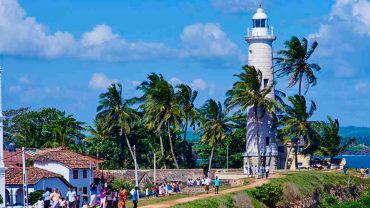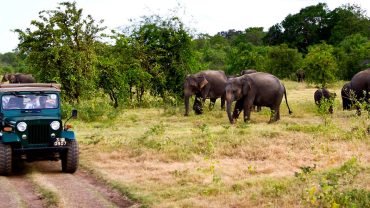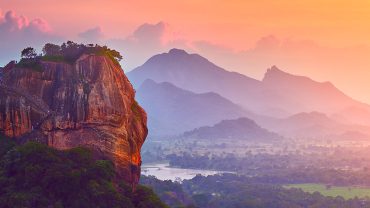Yucatan Travel Guide
1. Introduction: Discover the Magic of Yucatán
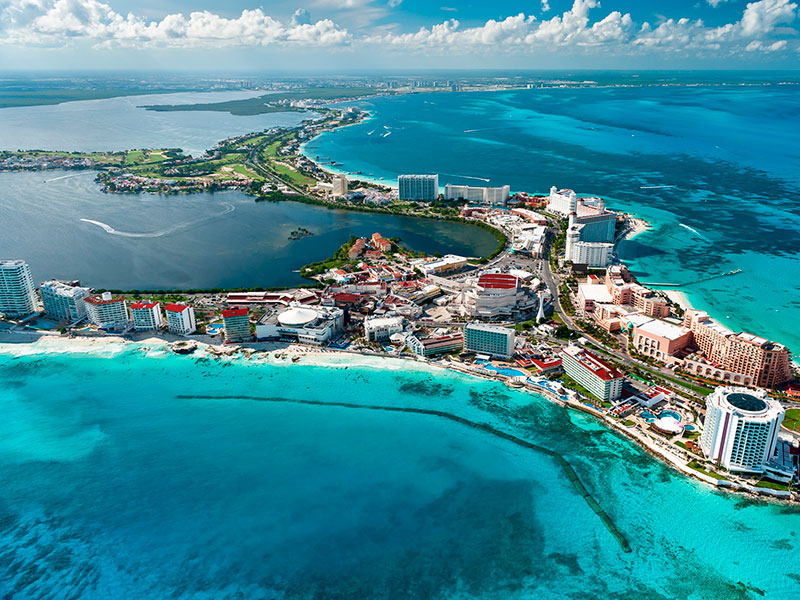
Ah, Yucatán! As our Yucatan Travel Guide will show you, this is a land of mystical ruins, emerald jungles, and azure waters that stretch as far as the eye can see. This remarkable Mexican state offers an unforgettable blend of culture, history, and natural beauty, making it an ultimate travel destination for all kinds of explorers. Whether you’re an adrenaline junkie eager to dive into secret cenotes, a history enthusiast ready to tread the steps of ancient Mayan pyramids, or a culinary adventurer yearning to savor the unique Yucatecan cuisine, Yucatán has something for everyone.
Situated in the southeastern part of Mexico, Yucatán is a place where ancient traditions coalesce with modernity, offering a fascinating tapestry of experiences. Just imagine waking up to the soothing sounds of the Caribbean Sea, spending your day unraveling the mysteries of Mayan civilization, and ending it with a picturesque sunset over the colonial cityscape of Mérida. Sounds idyllic, doesn’t it? And trust us, this is just the tip of the iceberg when it comes to what Yucatán has in store for you.
This comprehensive Yucatán Travel Guide is your one-stop resource for everything you need to know about this captivating destination, from must-see landmarks to hidden gems. So fasten your seatbelts as we take you on a journey through Yucatán’s most iconic spots, best-kept secrets, and everything in between.
Stay tuned to unearth the magic that awaits you in Yucatán!
2. Geography and Climate: The Natural Allure of Yucatán
The Yucatán Peninsula, situated in southeastern Mexico, is an intriguing geographical wonder that beckons tourists with its diverse landscapes and favorable climate. Separated from the rest of Mexico by low-lying jungle, the peninsula comprises three states: Yucatán, Quintana Roo, and Campeche. The region is enveloped by the Gulf of Mexico to the west and the Caribbean Sea to the east, forming a rich ecosystem teeming with marine life.
Landscapes
The land is a fascinating blend of low-lying rainforests, spectacular beaches, and mysterious limestone sinkholes known as cenotes. As you move further inland, the terrain shifts from coastal plains to rolling hills covered in a tapestry of tropical flora. Unlike many other parts of Mexico, Yucatán is mostly flat, making it easily navigable and perfect for road trips through quaint villages and stunning natural reserves like the Ría Celestún Biosphere.
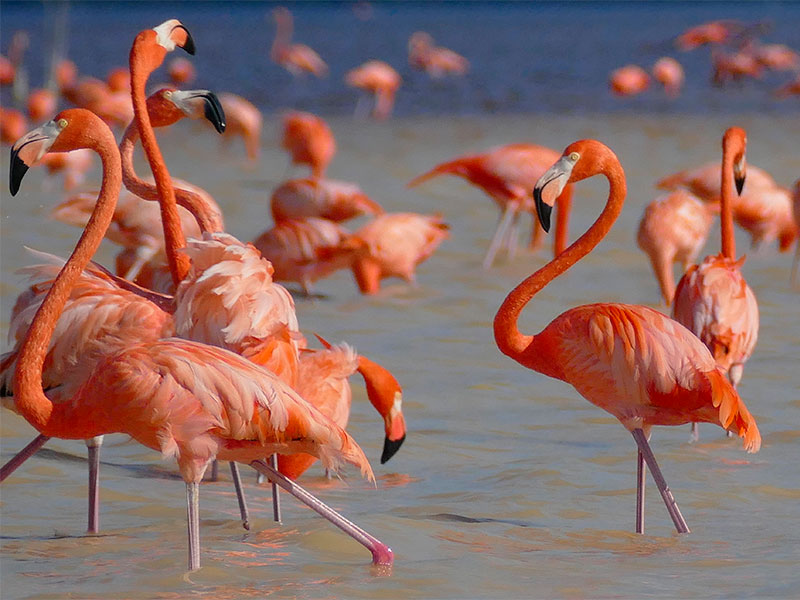
Climate
Yucatán enjoys a tropical climate, characterized by warm temperatures year-round. The area has two main seasons: the dry season, which lasts from November to April, and the rainy season, spanning from May to October. While the dry season is often considered the best time to visit, especially for outdoor activities like exploring cenotes and archaeological sites, the rainy season offers its own set of unique experiences. Think lush landscapes, fewer crowds, and the beauty of the Mexican Caribbean after a refreshing rain shower.
Weather Patterns
Temperature fluctuations are relatively mild, usually ranging from 70°F to 90°F throughout the year. The coastal areas tend to be slightly more humid but are often alleviated by ocean breezes. Hurricanes are most likely to occur between June and November, but they are relatively rare.
What to Pack
If you’re planning your trip during the dry season, light and breathable clothing is a must. Think linen, cotton, and moisture-wicking fabrics. Don’t forget a hat and sunscreen to protect yourself from the powerful sun. For the rainy season, pack light rain gear and perhaps a more robust pair of shoes for trekking through wetter terrain.
In summary, the geography and climate of Yucatán offer a rich and varied landscape that caters to every kind of traveler. Whether you’re here to bask on the sun-drenched beaches of the Riviera Maya or delve deep into the emerald jungles that surround ancient Mayan ruins, understanding the area’s geography and climate will undoubtedly enrich your travel experience. So pack your bags and prepare yourself for a journey through one of Mexico’s most enchanting regions.
3. Must-Visit Destinations: The Unmissable Gems of Yucatán
No trip to Yucatán would be complete without a visit to its iconic sites, each one brimming with unique history, culture, and natural beauty. From ancient Mayan ruins to idyllic beach towns, the region offers a broad spectrum of destinations that cater to a variety of interests. Here’s a list of must-see spots, as highlighted in our Yucatan Travel Guide, that should undoubtedly make their way onto your Yucatán itinerary.
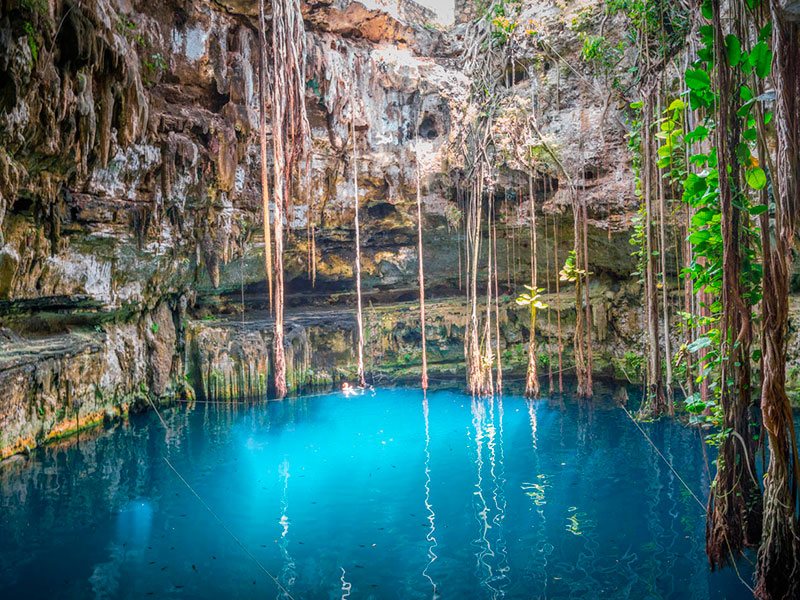
- Chichén Itzá: One of the New Seven Wonders of the World, this archaeological site showcases the grandeur of Mayan civilization like no other. The main pyramid, El Castillo, is a sight to behold, especially during the equinox when the sun casts a shadow creating the illusion of a serpent slithering down the staircase.
- Cenotes: These natural sinkholes formed by collapsed limestone are unique to the Yucatán Peninsula. Cenote Ik Kil, near Chichén Itzá, is particularly famous for its otherworldly beauty.
- Mérida: The capital city of Yucatán state, Mérida offers a harmonious blend of colonial architecture and modern amenities. Walk down Paseo de Montejo, a boulevard lined with European-style mansions, or explore the vibrant markets to get a taste of local culture.
- Uxmal: Another fascinating Mayan site, Uxmal is known for its complex architecture and intricate lattice work. Less crowded than Chichén Itzá, it offers a more peaceful exploration of Mayan history.
- Valladolid: This charming colonial town is the perfect gateway to explore surrounding cenotes and ruins. Its central square is a relaxing place to people-watch or dine in one of the many surrounding restaurants.
- Ría Celestún: A natural biosphere reserve that’s home to a large flamingo population. The nearby Celestún town offers beachside eateries and relaxed vibes.
- Izamal: Known as the Yellow City due to its golden-hued buildings, Izamal is a small town with a big historical footprint. Visit the Franciscan convent built atop a Mayan pyramid for a journey through centuries.
- Progreso: A port city on the Gulf of Mexico, it’s the go-to spot for beachgoers and features a long pier, ideal for a leisurely stroll with stunning sea views.
- Tulum: Although technically in neighboring Quintana Roo, it’s too exceptional to miss. Known for its cliffside ruins overlooking the Caribbean, Tulum also boasts some of the best beaches in Mexico.
- Sisal: If you’re looking for a more secluded beach experience, the small fishing village of Sisal offers just that, along with crystal-clear waters and pristine beaches.
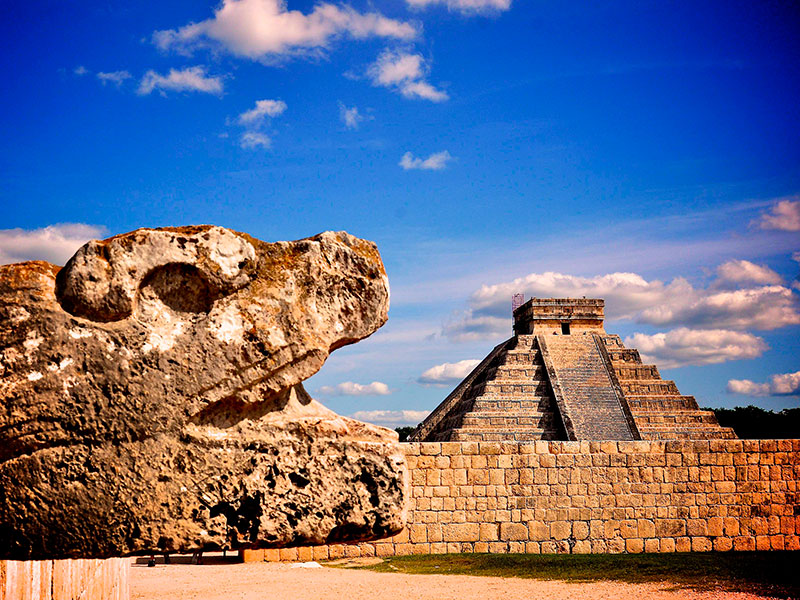
With such a plethora of attractions, Yucatán invites you to delve deep into its treasures. Whether you’re a nature enthusiast, a history buff, or a beach lover, the region offers experiences that are both enriching and exhilarating. Your only challenge will be fitting it all into one trip! So why wait? Start planning your dream vacation to Yucatán now and unearth the magic that awaits you in this Mexican paradise.
4. Historical Sites: A Journey Through Yucatán’s Rich Past
Yucatán’s appeal lies not just in its pristine beaches and natural wonders but also in its rich historical tapestry. This region of Mexico is a treasure trove of ancient ruins, colonial towns, and enduring traditions. Dive into the fascinating past of the Yucatán Peninsula by exploring its most captivating historical landmarks.
- Chichén Itzá: As previously mentioned, this UNESCO World Heritage site is a shining example of Mayan architecture and cosmology. From the massive El Castillo pyramid to the Temple of the Warriors, each structure reveals intricate details about Mayan civilization.
- Uxmal: Nestled in the Puuc hills, this ancient city offers architectural styles distinct from other Mayan sites. The Pyramid of the Magician and the Governor’s Palace are must-see landmarks, known for their detailed façades and symbolic carvings.
- Ek Balam: This less-visited Mayan site provides a peaceful atmosphere for exploring well-preserved sculptures and buildings. The Acropolis, the largest structure, contains fascinating friezes and offers panoramic views of the surrounding jungle.
- Haciendas: These colonial-era estates dotted across Yucatán are reminiscent of the region’s henequen (sisal) boom. Hacienda Yaxcopoil and Hacienda Sotuta de Peón have been restored and offer fascinating insights into the social and economic history of Yucatán.
- Franciscan Convents: After the Spanish conquest, Franciscan missionaries built a series of convents to convert the Mayan population. The Convent of San Antonio de Padua in Izamal is one such marvel, with its stunning atrium and intricate artwork.
- Kabah: Located south of Uxmal, this site is known for the Temple of Masks, adorned with hundreds of stone masks of the rain god, Chaac. It’s connected to Uxmal by an ancient ceremonial road called a sacbé.
- Coba: Although it’s closer to Quintana Roo, this sprawling ancient city is worth the trip. Known for Nohoch Mul, the tallest Mayan pyramid in the Yucatán, the site provides an adventurous experience as you can climb to the top for an awe-inspiring view.
- Mayapan: Often referred to as the last great Mayan capital, Mayapan offers an intimate experience with well-preserved murals and numerous temples, all without the crowds of more popular sites.
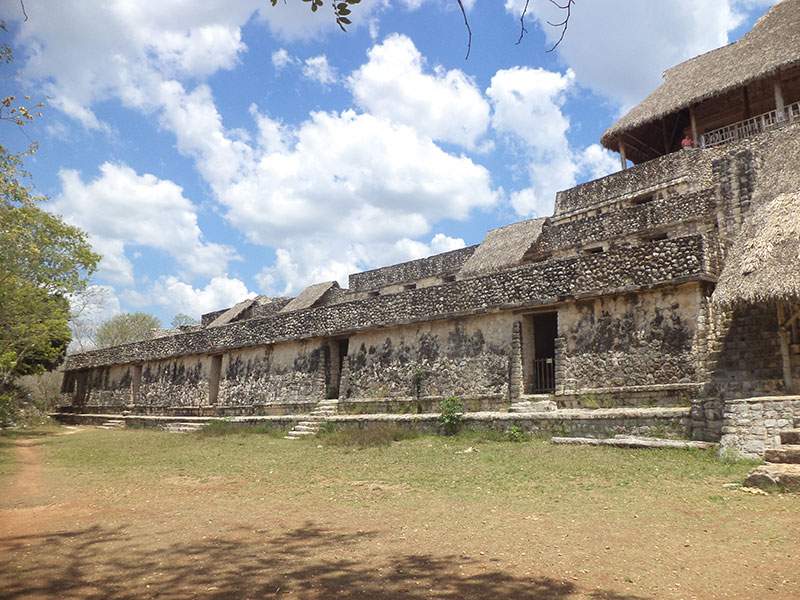
Exploring Yucatán’s historical landmarks is akin to stepping back in time. Each site serves as a chapter in a rich narrative that stretches from the ancient Mayans to colonial settlers. Immerse yourself in this storied past, and you’ll gain a deeper appreciation for the Yucatán beyond its obvious natural beauty. With every visit, you’ll uncover a layer of history that enriches your understanding of this multi-faceted region. Don’t just tour Yucatán; experience its living history and take a piece of it home with you in your memories, all with the aid of your Yucatan Travel Guide.
5. Natural Attractions: Yucatán’s Untouched Wonders
Yucatán is not only a playground of historical treasures but also a sanctuary of natural wonders, as our Yucatan Travel Guide details. From underwater caves to tropical jungles, the peninsula’s natural attractions are as diverse as they are magnificent. If you’re a nature enthusiast, this region promises a plethora of experiences that are both enchanting and educational.
- Cenotes: These natural sinkholes are unique to the Yucatán Peninsula. Sacred to the Mayans and vital to the ecosystem, cenotes like Ik Kil and Cuzamá offer an ethereal experience of swimming in crystal-clear waters amid stalactites and aquatic life.
- Ría Celestún Biosphere Reserve: Known for its stunning pink flamingo populations, this biosphere reserve is a paradise for bird watchers. A boat tour through the mangroves unveils various other bird species and even crocodiles!
- Sian Ka’an Biosphere Reserve: A UNESCO World Heritage site, this expansive reserve encompasses wetlands, coral reefs, and tropical forests. You can spot dolphins, turtles, and numerous bird species while kayaking or snorkeling.
- Grutas de Loltún: These caves offer a fascinating insight into the Mayan underworld, Xibalba. The cave walls are adorned with ancient carvings and paintings, while natural formations like stalagmites and stalactites make for an eerie, yet captivating, atmosphere.
- Calakmul Biosphere Reserve: Located in the south of Yucatán, this reserve houses one of the largest tropical forests in Mexico. A dream for ecotourists, Calakmul is home to jaguars, howler monkeys, and over 350 bird species.
- Tulum National Park: Though closer to Quintana Roo, the beaches of Tulum, with their cliff-top ruins, offer an unbeatable combination of history and natural beauty.
- Yucatán Coast: The lesser-visited beaches like Celestún and El Cuyo offer white sand and calm waters, perfect for relaxing or kitesurfing. Here, the ocean meets the sky in a symphony of colors that’s best enjoyed at sunset.
Amidst these natural wonders, Yucatán promises a rich tapestry of experiences that blend adventure with tranquility. Whether you’re plunging into the depths of a cenote, spotting vibrant wildlife, or simply taking in a serene sunset, Yucatán’s natural attractions are sure to leave a lasting imprint on your soul. It’s not just the landscape that is stunning, but the symbiotic relationship between the land and its creatures that truly embodies the spirit of Yucatán. Immerse yourself in these awe-inspiring natural sites and become a part of Yucatán’s enduring harmony with nature.
6. Activities: Experiencing the Essence of Yucatán
Engaging in activities in Yucatán goes beyond mere recreation; it’s a pathway to the soul of the region. From aquatic adventures to historical excursions, this vibrant destination has something for every kind of traveler.
- Water Sports: With a plethora of cenotes and a coastline that stretches for miles, water-based activities are abundant. Snorkeling in the cenotes, scuba diving to explore the underwater caves, and paddleboarding in the clear waters of the Gulf of Mexico are must-try experiences.
- Cultural Tours: Visiting the region’s numerous Mayan ruins, like Uxmal and Chichen Itzá, will not just be a sightseeing activity but also a journey back in time. Don’t forget to visit the local markets to get a glimpse of Mayan handicrafts.
- Adventure Sports: Jungle trekking and zip-lining in the thickets of the Calakmul Biosphere Reserve offer heart-pounding adventures, while bird-watching in the Ría Celestún Biosphere Reserve offers a more tranquil experience.
- Shopping: The colonial city of Mérida has a range of options, from flea markets selling traditional Yucatecan clothing to luxury stores offering the finest cigars and handicrafts.
- Nightlife: Mérida’s historic downtown comes alive at night with salsa dancing, live music, and street food that appeals to all your senses.
So, whether you’re an adrenaline junkie looking for an action-packed holiday or a history buff aiming to dig deep into the Mayan past, there’s no end to the unique activities you can engage in. If you’re more inclined towards shopping and nightlife, the urban centers offer a different kind of adventure that’s equally captivating.
Make Your Choice
In the Yucatán Peninsula, every day promises a new discovery. Guided by your Yucatan Travel Guide, from sunrise to sunset, there’s always an activity waiting to captivate your heart and broaden your horizons. So, make your choice and take the first step in crafting an unforgettable Yucatán adventure!
7. Culinary Experiences: A Flavorful Journey Through Yucatán
If there’s one thing that can rival the stunning landscapes and rich history of Yucatán, it’s the region’s diverse and delicious cuisine. The food in Yucatán is a delectable blend of Mayan and Spanish influences, seasoned with a dash of Caribbean flair. One bite of any Yucatecan dish will transport you to the essence of the region itself—complex, flavorful, and deeply rooted in tradition.
- Cochinita Pibil: A quintessential dish, Cochinita Pibil is slow-roasted pork marinated in achiote paste and orange juice. This tender and flavorful masterpiece is usually served with pickled red onion and tortillas. Restaurants and food stalls around the city of Mérida are prime spots to relish this dish.
- Panuchos and Salbutes: These are deep-fried tortillas filled or topped with a variety of ingredients like shredded chicken, tomatoes, and avocados. Panuchos and Salbutes can be found in almost any local market or street corner.
- Papadzules: A dish of corn tortillas filled with boiled eggs and then dipped in a pumpkin seed sauce. This is a vegetarian favorite that’s both fulfilling and flavorful.
- Sopa de Lima: A tangy lime soup often served with shredded chicken and crispy tortilla strips, offering a burst of flavors with each spoonful.
- Seafood: Given Yucatán’s extensive coastline, the region is a paradise for seafood lovers. Fresh catches like grouper and snapper can be enjoyed in coastal towns like Progreso and Celestún.
Where to Dine
When it comes to finding places to eat, you’re spoilt for choice. In Mérida, the capital, you’ll find a wide array of options from street vendors selling local fast food to high-end restaurants that offer a luxurious dining experience.
Savor the Tastes of Yucatán
Embarking on a culinary tour in Yucatán is not just about tasting; it’s about experiencing the rich cultural heritage through its food. So, when you’re here, make sure to take your palate on a journey as adventurous as your explorations around the region. Every bite will deepen your understanding of why people consider Yucatecan cuisine one of the world’s most unique and satisfying gastronomic experiences.
8. Local Festivals and Events: A Kaleidoscope of Yucatecan Culture
Yucatán’s vibrant cultural landscape is most vividly showcased during its festivals and events. These celebrations are an amalgamation of ancient traditions, colonial influences, and modern-day rituals. For travelers interested in delving into the rich tapestry of Yucatán’s culture, there’s no better time to visit than during these festivals.
- Day of the Dead: Known as Hanal Pixán in the Yucatán, the Day of the Dead is an exceptional experience. Families gather to honor their deceased loved ones with offerings and visits to cemeteries. Altars are erected with photographs, favorite foods, and cherished belongings. The atmosphere, far from being somber, is festive and colorful.
- Guelaguetza Festival: While this is a festival primarily celebrated in Oaxaca, its influence has trickled down to the Yucatán as well. Here, you can witness traditional music, dance, and food from various regions, celebrating the diversity and unity of Mexican culture.
- Carnaval de Mérida: Taking place in the capital city, this festival is full of parades, costumes, and dances. It’s a lively affair that usually happens in the weeks leading up to Lent.
- Festival de la Ciudad: Celebrated in Mérida, this festival marks the city’s birthday and features a wide array of events including concerts, exhibitions, and culinary events that showcase Yucatecan culture.
- Chicxulub Crater Festival: This event celebrates the scientific and historical importance of the Chicxulub Crater, believed to be the impact site of the asteroid that caused the extinction of the dinosaurs. It features workshops, exhibitions, and guided tours of the area.
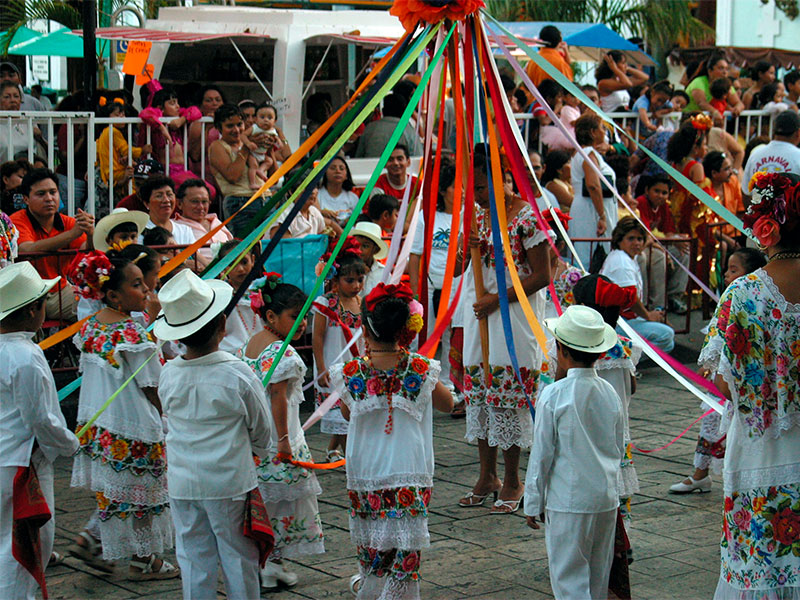
Why You Should Experience These Festivals
Each of these events offers a unique lens through which to understand Yucatán’s rich cultural and historical landscape. They are not just for entertainment but are deeply entwined with the identity of the region’s people. Taking part in these celebrations is akin to becoming a part of this ongoing story of tradition and change.
So, when planning your visit, make sure to check the local event calendar. The festivals are the soul of Yucatán, and participating in them will add an unforgettable layer to your travel experience. Immerse yourself in the cultural richness and come away with memories that will last a lifetime.
9. Accommodations: From Budget-Friendly to Ultimate Luxury
In Yucatán, you’ll find a wide array of accommodation options that cater to diverse preferences and budgets. Whether you’re an intrepid backpacker or a traveler seeking the epitome of luxury, there’s something for everyone here.
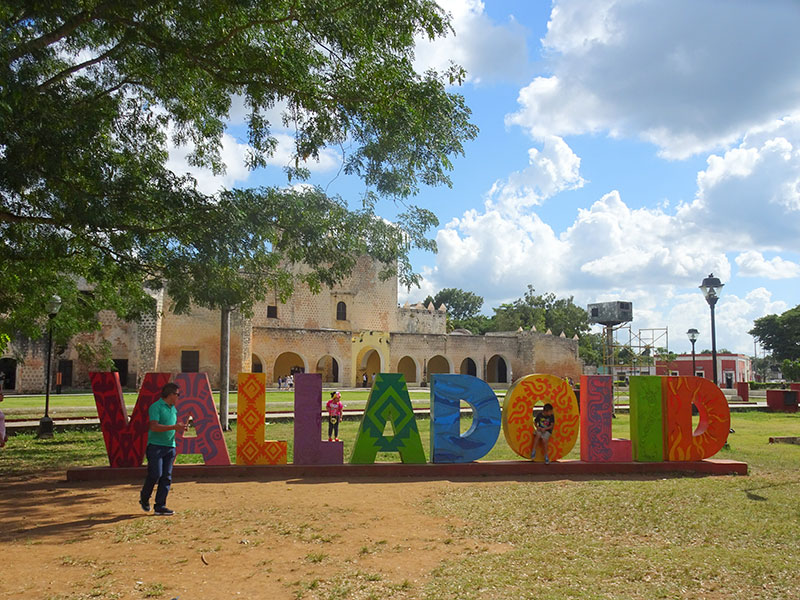
Budget Stays:
- Hostel Nómadas: Located in Mérida, this hostel is perfect for travelers looking for a sociable, budget-friendly stay. It has a communal kitchen, swimming pool, and organizes regular cultural activities.
- Valladolid Hostel: Situated in the charming town of Valladolid, this hostel is another excellent option for those looking to save but not skimp on experience.
- Camping in Celestún: For those who love to be close to nature, camping near the Celestún Biosphere Reserve offers a one-of-a-kind experience at an affordable rate.
Mid-Range Hotels:
- Hotel Hacienda Mérida: An elegant yet reasonably priced option in the heart of Mérida, offering colonial charm with modern amenities.
- Mayan Bungalow in Uxmal: Get close to the archaeological wonders in a comfortable setting, offering an authentic Yucatecan experience.
Luxury Resorts:
- The Hacienda Xcanatún: Situated near Mérida, this former 18th-century sisal plantation turned luxury hotel offers an exquisite blend of historical elegance and modern comforts.
- Chablé Resort & Spa: Located in the Yucatecan jungle, this resort is the epitome of luxury, offering private villas and a world-class spa focused on Mayan healing traditions.
Why Choose the Right Accommodation in Yucatán
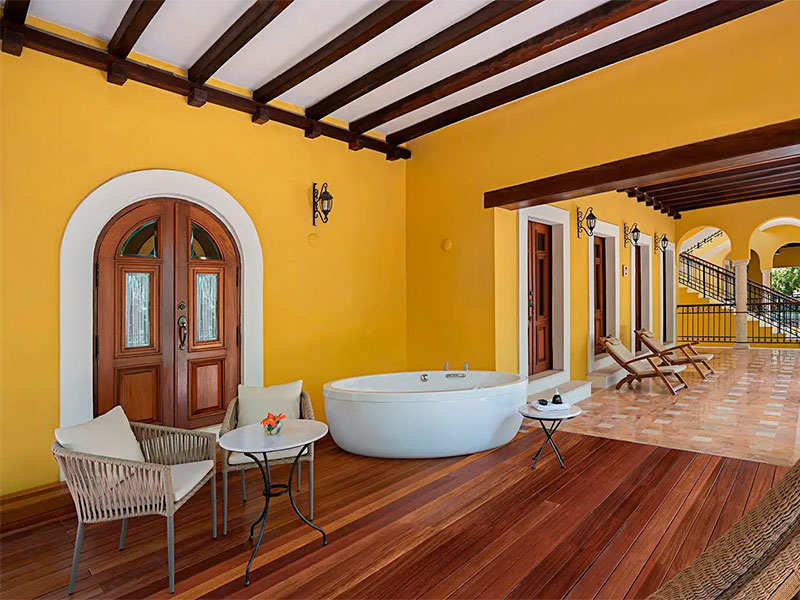
Selecting the right accommodation can significantly enhance your travel experience. It serves as your home base for exploring the region’s historical sites, natural attractions, and vibrant festivals. Always consider the type of experience you wish to have: whether it’s budget-traveling and socializing with other tourists, immersing yourself in local culture, or indulging in a luxurious escapade.
Your choice in accommodation could be the difference between a good vacation and an unforgettable one. In Yucatán, you’re spoiled for choice. So, do your research, consider your priorities, and make the most out of your Yucatecan adventure.
10. Practical Information: Navigating Your Way in Yucatán
To make the most of your visit to this captivating region full of history, culture, and natural beauty, consult our Yucatan Travel Guide. It’s crucial to know some practical information concerning transportation, weather, and local customs.
Transportation:
- Public Buses: A convenient and affordable way to get around, especially for short distances. In Mérida, the local bus network is extensive.
- Colectivos: These are shared mini-vans that operate on specific routes and are an inexpensive way to travel between towns.
- Taxis and Ride-Sharing: These are available in larger cities like Mérida and are a more convenient but slightly costlier option.
Weather:
- Best Time to Visit: The ideal months are December to April when the weather is relatively cool and dry.
- What to Pack: Light clothing is generally acceptable year-round, but don’t forget a jacket for cooler evenings and an umbrella for the occasional shower.
Local Customs and Etiquette:
- Greetings: A simple ‘Hola’ goes a long way. Handshakes are common among men, while women often exchange a small kiss on the cheek.
- Public Decorum: Yucatecans are generally polite and conservative. Dress modestly when visiting religious or traditional sites.
- Gratuities: Tipping is customary in restaurants, with 10-15% being the standard rate.
Knowledge of these practical aspects will not only make your trip more comfortable but also help you engage more deeply with the local culture. Being informed about navigating the public transport system and understanding local customs will enrich your Yucatecan experience significantly. So, prepare your plans in advance and get ready to embrace all the incredible offerings of this region.
11. Conclusion: Why Yucatán is Your Next Unforgettable Journey
Guided by our Yucatan Travel Guide, we’ve explored Yucatán’s intricate tapestry. This region is clearly a treasure trove of undiscovered experiences. From the awe-inspiring ancient ruins to the lush natural attractions, and from the rich culinary landscape to the heartwarming local festivals, Yucatán offers a comprehensive travel experience that caters to all kinds of interests.
Final Tips for Potential Travelers:
- Plan Ahead: While spontaneity has its charm, some attractions may require advanced booking. Do your research to maximize your experience.
- Local Interaction: Engage with the local community. Not only will this enhance your travel experience, but it will also provide you with valuable insights into the region’s culture.
- Stay Hydrated: Given the region’s warm climate, it’s essential to keep hydrated, especially when undertaking physically demanding activities.
- Local Cuisine: Don’t leave without trying Cochinita Pibil. Local eateries or “taquerias” are often the best places to experience authentic flavors.
- Respect Local Customs: When visiting religious or traditional sites, dress modestly and follow any posted guidelines.
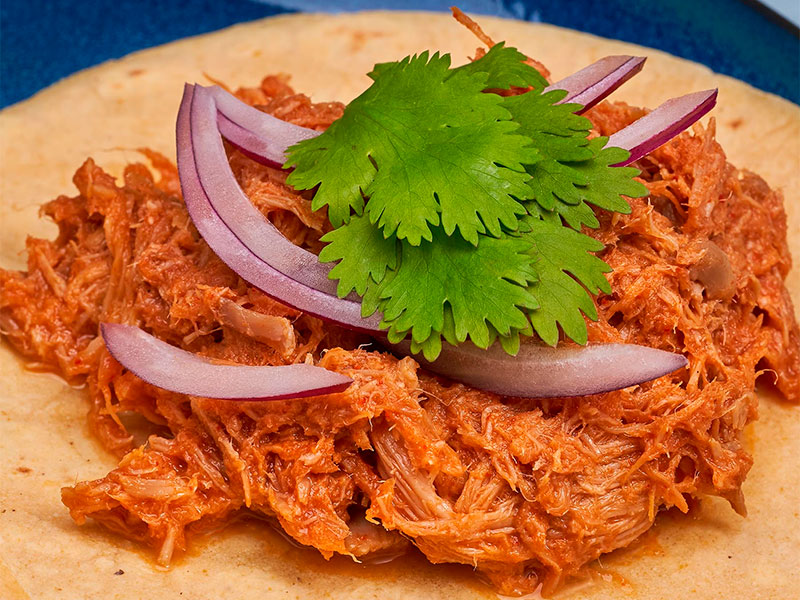
In summary, Yucatán is more than just a destination. It offers a vivid tableau of history, culture, and natural beauty. As outlined in our Yucatan Travel Guide, you shouldn’t just see, hear, or taste the sights, sounds, and flavors of this extraordinary region; you should feel them with all your senses. So, what are you waiting for? Dive into the magic that is Yucatán and let it leave an indelible mark on your traveler’s soul.
12. Frequently Asked Questions About Traveling to Yucatán
- What is the best time to visit Yucatán?
The optimal time to visit is between November and April when the weather is pleasant. However, if you don’t mind some rain and humidity, the off-season offers fewer crowds and lower prices. - Is Yucatán safe for tourists?
Yucatán is generally considered safe for tourists. However, it’s always advisable to take standard safety precautions, such as avoiding poorly lit areas at night. - Do I need a visa to visit?
Visa requirements vary based on your nationality. Many visitors from the U.S., Canada, and EU countries do not require a visa for short stays. Always check current visa regulations before planning your trip. - How do I get around Yucatán?
Public transportation is well-developed in urban areas. For more flexibility, consider renting a car, especially if you plan to explore remote areas. - What currency is used?
The Mexican Peso is the official currency. Most places accept credit cards, but we advise carrying some cash for smaller establishments. - What should I pack?
Pack light, breathable clothing for the hot climate, along with sunscreen and bug spray. We recommend wearing modest clothing when you plan to visit religious or historical sites. - Is English widely spoken?
People in tourist areas commonly understand English, but learning a few basic phrases in Spanish can make your experience better. - What are the must-try foods?
Cochinita Pibil is a local delicacy you shouldn’t miss. Tamales, Panuchos, and Sopa de Lima are other must-try dishes. - What are the key historical sites?
Chichen Itza, Uxmal, and Ek Balam are among the most prominent historical sites, offering a glimpse into the Mayan civilization. - Are there any local customs I should be aware of?
Yucatecans are generally warm and hospitable. When entering someone’s home, it’s customary to greet each person individually. Always ask permission before taking photos of people, especially indigenous communities.
With these answers in hand from our Yucatan Travel Guide, you can fully prepare to maximize your Yucatán adventure. Dive deep into this versatile region’s enriching experiences. You’ll return home with memories to last a lifetime.

